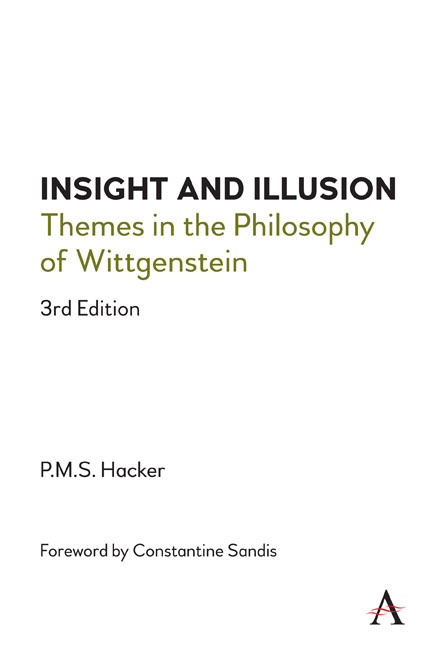Book contents
- Frontmatter
- Dedication
- Contents
- FOREWORD
- PREFACE TO THE REVISED EDITION
- PREFACE TO THE FIRST EDITION
- LIST OF ABBREVIATIONS
- I WITTGENSTEIN’S EARLY CONCEPTION OF PHILOSOPHY
- II THE DIALOGUE WITH FREGE AND RUSSELL
- III MEANING, METAPHYSICS, AND THE MIND
- IV EMPIRICAL REALISM AND TRANSCENDENTAL SOLIPSISM
- V DISINTEGRATION AND RECONSTRUCTION
- VI WITTGENSTEIN’S LATER CONCEPTION OF PHILOSOPHY
- VII METAPHYSICS AS THE SHADOW OF GRAMMAR
- VIII THE REFUTATION OF SOLIPSISM
- IX PRIVATE LINGUISTS AND PUBLIC SPEAKERS
- X ‘A CLOUD OF PHILOSOPHY CONDENSED INTO A DROP OF GRAMMAR’
- XI CRITERIA, REALISM AND ANTI-REALISM
- INDEX
III - MEANING, METAPHYSICS, AND THE MIND
Published online by Cambridge University Press: 24 February 2022
- Frontmatter
- Dedication
- Contents
- FOREWORD
- PREFACE TO THE REVISED EDITION
- PREFACE TO THE FIRST EDITION
- LIST OF ABBREVIATIONS
- I WITTGENSTEIN’S EARLY CONCEPTION OF PHILOSOPHY
- II THE DIALOGUE WITH FREGE AND RUSSELL
- III MEANING, METAPHYSICS, AND THE MIND
- IV EMPIRICAL REALISM AND TRANSCENDENTAL SOLIPSISM
- V DISINTEGRATION AND RECONSTRUCTION
- VI WITTGENSTEIN’S LATER CONCEPTION OF PHILOSOPHY
- VII METAPHYSICS AS THE SHADOW OF GRAMMAR
- VIII THE REFUTATION OF SOLIPSISM
- IX PRIVATE LINGUISTS AND PUBLIC SPEAKERS
- X ‘A CLOUD OF PHILOSOPHY CONDENSED INTO A DROP OF GRAMMAR’
- XI CRITERIA, REALISM AND ANTI-REALISM
- INDEX
Summary
The Picture Theory of Meaning
On 29 September 1914 Wittgenstein, in his notebook, referred to the fact that in law courts in Paris a motor car accident is represented by a model employing toy cars and figures. It struck him that there is not merely an analogy between the way such a model represents the facts of the accident and the way a proposition represents a situation, but rather that a model, a picture, a proposition are severally special cases of representation and must share certain common features in virtue of which they canrepresent whatever it is that they represent. In all such cases the representation must, in some way, be co-ordinated with what it represents. Yet, it may represent falsely, for things may notbe related as it represents them as being. Rather, as in the model, ‘a world is as it were put together experimentally’ (NB,p. 7). The representation can be true or false, but it must have a senseindependently of its truth or falsehood, it must represent a possibleconfiguration of things even if not an actual one.
From this seed grew the famous picture theory of meaning for which the Tractatusis best known. It is important, however, not to exaggerate the importance of the new idea that a proposition is a picture, a logicalpicture, of a situation. A great many of the ingredients of the Tractatusconception of meaning and representation had occurred to Wittgenstein well before this idea crossed his mind. It enabled him to weld together into a unified whole the thoughts which he had been developing since 1912, as well as leading to what seemed to be fresh insights. I shall try to give a brief sketch of the central points of the picture theory.
First, bear in mind some of the antecedent commitments. The most fundamental was the idea of the bipolarity of the proposition. This had occurred to Wittgenstein very early. While he had never thought Frege right in saying that propositions refer to truth-values, he did originally think that a proposition refers to a fact (has a fact as its Bedeutungor meaning).
- Type
- Chapter
- Information
- Insight and IllusionThemes in the Philosophy of Wittgenstein, pp. 56 - 80Publisher: Anthem PressPrint publication year: 2021



